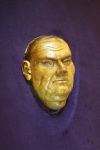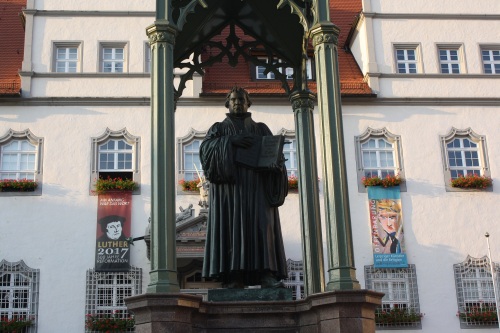
Martin Luther Statue, Wittenberg. Photo by Richard Varr
Following in Martin Luther’s Footsteps

Luther cast from death mask, Halle. Photo by Richard Varr
The faint light reveals his sallow color, his face so life-like that I can almost believe he’s sitting right in front of me. I’m looking at the waxen mold of the face cast from Martin Luther’s death mask, one of the most sensational exhibits I saw during my week in Germany. It’s an exciting time over the coming year as the country and the world celebrate the 500th anniversary of the Protestant Reformation in 2017.
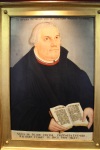
Luther painting, Museum of City History, Leipzig.
It all started in 1517 when Luther, then a monk, boldly protested against the Catholic Church’s practice of selling tickets for forgiveness of sins called indulgences, arguing money can’t buy God’s forgiveness. Luther nailed his 95 Theses of protest on a church door in Wittenberg, where my journey began as I followed in his footsteps. Luther is a key figure in German history – his rebellion resulting in the Lutheran and other Protestant religions, and his translation of the Bible from Latin leading to the development of the German language today.
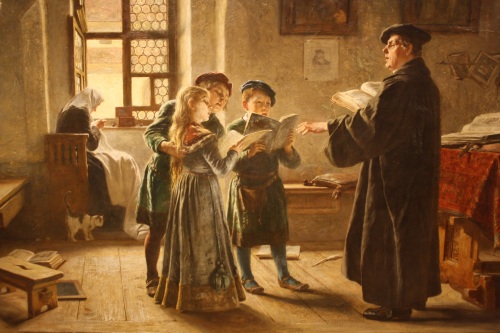
Painting in Luther House Museum, Wittenberg. Detail. Courtesy Luther House Museum.
In September, I visited some of the key towns where Luther lived and preached; where he was born and where he died. I visited some of the original homes, castles and churches that remain today, 500 years later, as these towns celebrate this remarkable heritage. On a personal note, my grandmother on my father’s side came from Germany.

Church door, Castle Church, Wittenberg. Photo by Richard Varr
This blog post will highlight just some of the things to see and do in the coming year. There are so many buildings, references to historical events and footnotes to one of history’s greatest religious movements that I simply cannot fit into just one blog post. I suggest booking a trip to Germany, like I did, and see it all for yourself! I traveled on assignment, flying into Leipzig, and then renting a car and driving between towns, all within 1-2 or so hours of each other. My assigned story will appear in May 2017 on the website of the American Automobile Association’s Home&Away Magazine, www.homeandawaymagazine.com (enter zip code 73099), with references in the actual magazines as well.
FOR MORE INFORMATION: www.visit-luther.com
www.germany.travel

Wittenberg central square. Photo by Richard Varr
Wittenberg: Birth of the Reformation

Luther’s Tomb, Castle Church, Wittenberg. Photo by Richard Varr
A larger than life statue of Martin Luther in a flowing long robe stands high on a granite pedestal, the centerpiece of Wittenberg’s central Market Square surrounded by the whitewashed Town Hall and muted earthen-toned buildings. I look up at the Great Reformer and imagine what he was thinking when, just down the street from here, he nailed his 95 Thesis on the door of the Castle Church. The church with its imposing rounded tower has just been refurbished for the anniversary. Inside are the tombs of Luther and the Reformation’s other key leader, Philipp Melanchthon. And while the actual wooden door where the Theses were nailed is long gone, it has been replaced by a bronze door with intricate carvings of the Theses’ actual words.
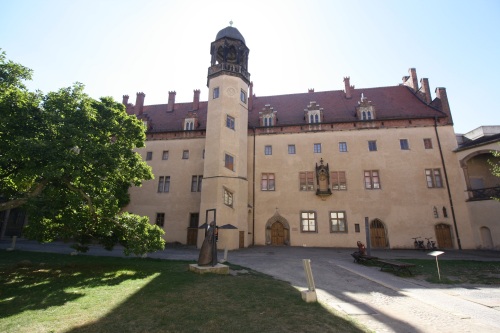
Luther House Museum, Wittenberg. Photo by Richard Varr
The colossal four-story Luther House, once an Augustinian monastery and the world’s largest museum showcasing the Reformation, sits alongside a quiet courtyard fronted by a life-sized statue of Luther’s wife Katharina von Bora. Inside are some of Luther’s important papers and pamphlets, Bibles, his pulpit, paintings and the Luther Room, part of where his family lived.
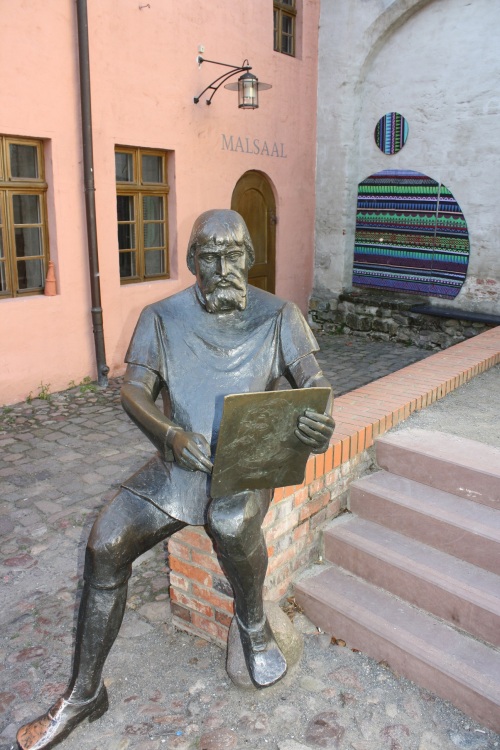
Cranach the Elder statue, Wittenberg. Photo by Richard Varr
The old master Lucas Cranach the Elder was another of Wittenberg’s famous sons, with buildings he owned enveloping a courtyard that once housed his own art studio, pharmacy and printing businesses.

Castle Church tower. Photo by Richard Varr
For 2017, the town has already built an impressive round panorama with a giant painting of Wittenberg in Luther’s time. The World Reformation Exhibition scheduled to run next summer will include seven “Gates of Freedom,” with the Welcoming Gate as a lookout tower. “We will develop discussion platforms, rooms and spaces so people can exchange ideas about the Reformation – what it meant 500 years ago, what it means now and what will come of it 500 years from now,” says project marketing director Cathrine Schweikardt.

Panorama painting. Courtesy Asisi Panorama Wittenberg 1517.
Photo by Tom Schulze

Courtesy Asisi Panorama,Wittenberg.
Photo: by Tom Schulze
Halle: A Life-Like Glimpse of the Reformer
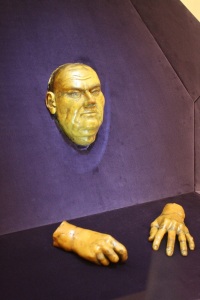
Luther cast of death mask and hands, Halle. Photo by Richard Varr
Luther preached in Halle many times during his lifetime. His eerie likeness – the original wax cast of his death mask and hands – is tucked away in a small room of Halle’s four-tower Market Church that anchors the city’s central square. The church’s historic library houses many original documents, including the first 1534 edition of Luther’s translated Bible. “Luther used a common German language and because of that, we can say that he invented the modern common German language because of his translation of the Bible,” says Halle city tour guide Hans-Joachim Kres.

Luther’s handwriting in Bible. Photo by Richard Varr
Other library documents include a Bible Luther presented to a noble family with original script written by Luther himself and a mention of the 1685 baptism one of the city’s favorite sons, composer Georg Frideric Handel, written in a church log.
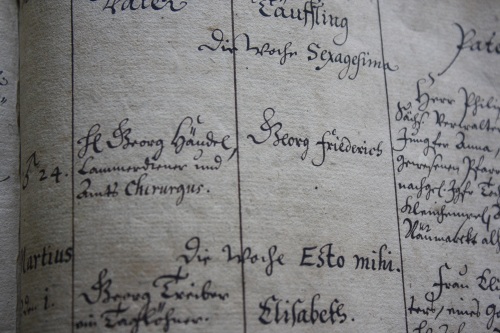
Handel baptism entry. Photo by Richard Varr

Handel Museum, Halle. Photo by Richard Varr
Other Halle sights include the Handel Museum (the composer was born there), and the Moritzburg Art Museum housed in the late 15th century castle of the same name.

Moritzburg Castle. Photo by Richard Varr
Eisleben and Mansfeld
At the end of his life, an extremely ill Martin Luther trudged along dirt roads in winter to where he was born in 1483, the countryside town of Eisleben at the foot of the Harz Mountains. It’s also where he died. A reconstruction of his birth home is now the Luther Birthplace Museum, highlighting his early life and final days through exhibits showcasing his father’s copper mining activities and Luther’s baptismal font from 1518.

Inside the Death House Museum. Photo by Richard Varr
The Death House Museum, just off the town square, showcases paintings of his final hours and exhibits of describing his bouts with kidney stones and heart disease. Most impressive is the original pall – now dramatically faded – that covered his coffin when he died in 1546.

Luther’s parents house, Mansfeld. Photo by Richard Varr
As a child, Luther’s parents moved to the nearby town of Mansfeld. Their original small brick home where young Martin lived from 1484-1497 still stands as a museum. Across the street, an exhibition hall showcases artifacts – coins, colored window glass, nails, marbles and more – the family used, unearthed on the very site during an archeological excavation.
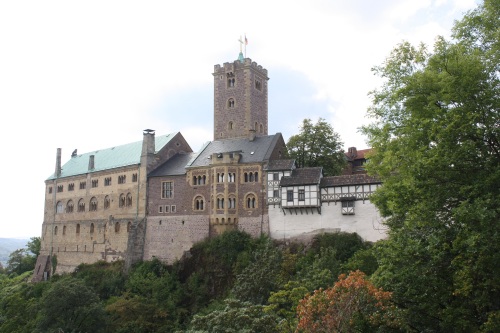
Wartburg Castle. Photo by Richard Varr
Eisenach
After he was denounced by the Catholic Church, Martin Luther took refuge for 10 months in Wartburg Castle, a fortification perched on a hilltop outside Eisenach. In a small wood-paneled room, he would sit at a desk where he translated the Bible’s New Testament.
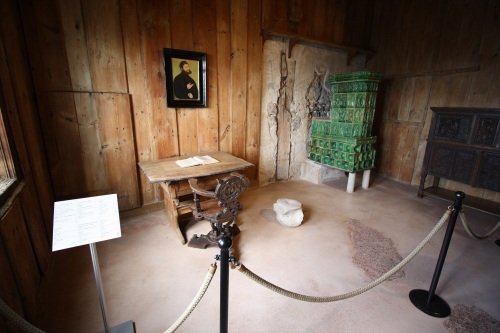
Luther’s room, Wartburg Castle. Photo by Richard Varr

Luther House, Eisenach. Photo by Richard Varr
In town, the Luther House with its half-timbered façade is now a museum. Owned by a town councilman who lived there with his family, Luther boarded at the home from 1498-1501 while attending a local school. Upstairs is the so-called Luther Room where it’s believed he slept, with one beam in the wall dating back to 1269.

Luther Room, Eisenach. Photo by Richard Varr
Luther sang with the school’s boys’ choir. And maybe it’s no coincidence that Luther had so much in common with another of the town’s favorite sons, composer Johann Sebastian Bach, who was born in Eisenach. “Luther was the initiator of Lutheran church music. Without Luther, we wouldn’t have the music of Bach who realized the ideas of Luther for his own music,” says Eisenach tour guide Cornelia Hartleb. The renovated Bach House was the first Bach Museum on the actual site of the house where Bach was born in 1685.

Twin churches on Domplatz, Erfurt. Photo by Richard Varr
Erfurt
Erfurt’s medieval skyline at nightfall is breathtaking. Spotlights bring sharply into focus the twin houses of worship dominating the view: St. Mary’s Cathedral and the Church of St. Severus, separated by a colossal stairwell on the central square Domplatz. Luther studied law in Erfurt, but soon vowed to become a monk if he survived a fierce thunderstorm when trapped in nearby fields.
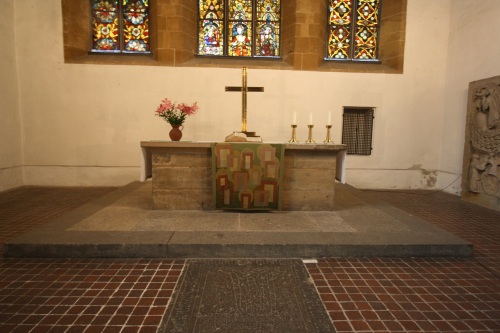
Altar of Luther’s first sermon, Erfurt. Photo by Richard Varr
After the storm, he entered the Augustinian Monastery to fulfill his promise and was later ordained as a Catholic priest. Today, the Monastery is a Protestant conference center and houses exhibits including a library, artifacts and original prayer cells. Next door, I enter the nave of St. Augustine Church and see the original altar where Luther gave his first sermon.
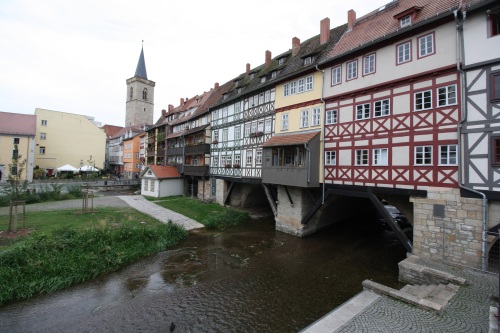
Merchants’ Bridge, Erfurt. Photo by Richard Varr
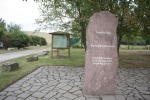
Luther Stone. Photo by Richard Varr
With a population of about 400,000, Erfurt has retained its medieval heritage with its centerpiece Merchants’ Bridge, lined with cafes and shops along its cobbled road over part of the Gera River. The large Luther Stone in nearby countryside marks the spot where Luther feared for his life during the thunderstorm.

Schmalkalden’s scenic half-timbered homes. Photo by Richard Varr
Schmalkalden
Classic German half-timbered houses line the cobbled streets of Schmalkalden, a small town nestled along the edges of the Thuringian Forest. Some of those structures date back to the 13th and 14th centuries with their crisscross of beams, red tile roofs and white and cool-colored facades. One of those houses is this town’s Luther House, where the reformer stayed during the Schmalkaldic League’s meetings in 1537.

Luther House.
The League was a group of Protestant counts and princes teaming together to further the cause of the new Lutheran religion created by the Reformation. Luther preached in the original upstairs rooms when too sick to attend meetings at the Town Church of St. George, where he gave sermons only twice because of likely kidney stones. If you have the energy, you can hike up 158 steps along the narrowing, twisting stairwell of the town’s tower with splendid views of Schmalkalden’s central square.

Auerbach’s Cellar, Leipzig. Photo by Richard Varr
Leipzig

Madler Passage, Leipzig. Photo by Richard Varr
Throughout his life, Martin Luther visited the city that Bach called home. Along Mädler Passage, one of Germany’s best known arcade buildings, I visit the underground Auerbach’s Cellar, one of Leipzig’s most popular restaurants. During Martin Luther’s time it was a wine bar for students owned by Heinrich Stromer, a professor of medicine. Stromer took in Luther who was disguised as a bearded “Squire George” when hiding out from the Catholic Church. A modern-day painting of them together hangs on a wall there.

Katharina von Bora’s wedding ring in the Museum of City History, Leipzig.
The Museum of City History in the Old Town Hall exhibits a portrait of Luther, some of his writings, one of his goblets, and perhaps most interesting, the wedding ring of his wife Katharina von Bora. The museum also has one of Bach’s classic portraits from 1746. The same Bach portrait, meanwhile, sits inside St. Thomas Church’s museum where Bach was music director for 27 years.

Bach statue, St. Thomas Church. Photo by Richard Varr
FOR MORE INFORMATION:
www.visit-luther.com
www.germany.travel
